The Metaverse Explained: A Simple, In-Depth Guide
- Glossary of Related Terms
- What Is a Metaverse?
- The History of the Metaverse
- What Does the Metaverse Look like Today?
- What Could the Metaverse Look like in the Future?
- Technologies Shaping the Metaverse
- Key Features of the Metaverse
- Challenges Presented by the Metaverse
- The Metaverse’s Use Cases
- Major Players in the Metaverse
- How to Access the Metaverse
- Conclusion
- Frequently Asked Questions
Metaverse. You’ll probably have heard the word from Big Tech companies like Meta, Microsoft, and Google. But what exactly is it? What will it look like? And how could it change our lives?
The metaverse is a network of 3D virtual reality worlds that are currently under construction. When they’re complete, these spaces will be enabled by both existing and emerging technologies. Plus a few that haven’t even been invented yet.
In this article, we’ll paint a picture of the metaverse to help you figure out where it came from and where it’s going; explore its potential perks and pitfalls; and better understand how this digital world could change our real one.
So, grab your VR goggles and let’s go!
Glossary of Related Terms
Web 3.0 or Web3
The envisioned next phase of the World Wide Web, set to be largely based on blockchain technology. It will be characterized by decentralized networks and significantly greater user empowerment.
Decentralization
The distribution of control and authority across multiple parties, rather than this power being concentrated in the hands of a single entity.
In the context of blockchain, it means a system where operations and decision-making are spread out across a network of computers, enhancing security and reducing reliance on any one point of failure.
Virtual reality (VR)
An immersive, computer-generated 3D environment that can be explored and interacted with as if it were tangible. This environment is typically accessed through specialized equipment; usually a VR headset with a built-in screen. In some cases, users may also wear sensor-fitted gloves that enable tactile feedback.
Augmented reality (AR)
A technology that superimposes digital information, such as graphics, sounds, or other sensory data, onto users’ real-world surroundings through devices like smartphones or VR headsets. AR offers the potential to merge digital experiences with our physical surroundings.
Blockchain
A secure, decentralized database that groups transactions into “blocks” that are linked together to form a tamper-evident record.
Unlike traditional centralized databases, blockchains use “consensus mechanisms”—or pre-defined algorithms—to collectively verify the validity of changes. In other words, instead of relying on a single central authority, blockchain networks have multiple participants who must agree on any updates or transactions, ensuring a higher level of security.
Cryptocurrency
A digital currency that uses cryptographic techniques to secure transactions. Unlike fiat currencies, cryptocurrencies operate on decentralized platforms (e.g. blockchain) and are not governed by any central authority.
Non-fungible token (NFT)
A unique digital identifier that represents ownership of a specific item or piece of digital content, like a unique digital artwork.
Unlike cryptocurrencies, each NFT has unique metadata and an identification code. This identifier is recorded on a blockchain to signal the ownership of a particular digital asset.
Avatar
A 3D model or a 2D icon representing a user in a virtual environment or game. Avatars provide users with a personalized virtual identity and help to facilitate user interaction in virtual worlds.
Artificial intelligence (AI)
The ability of computers or machines to perform tasks that usually require human intellect. AI can interpret and learn from data or human language, recognize patterns, and solve complex problems.
Smart contract
Automated contracts with terms written in code and executed on the blockchain to eliminate the need for intermediaries.
Interoperability
The ability for different systems, devices, or applications to operate in conjunction with each other.
In the metaverse, interoperability would allow for a seamless experience as users navigate between different platforms and experiences.
What Is a Metaverse?
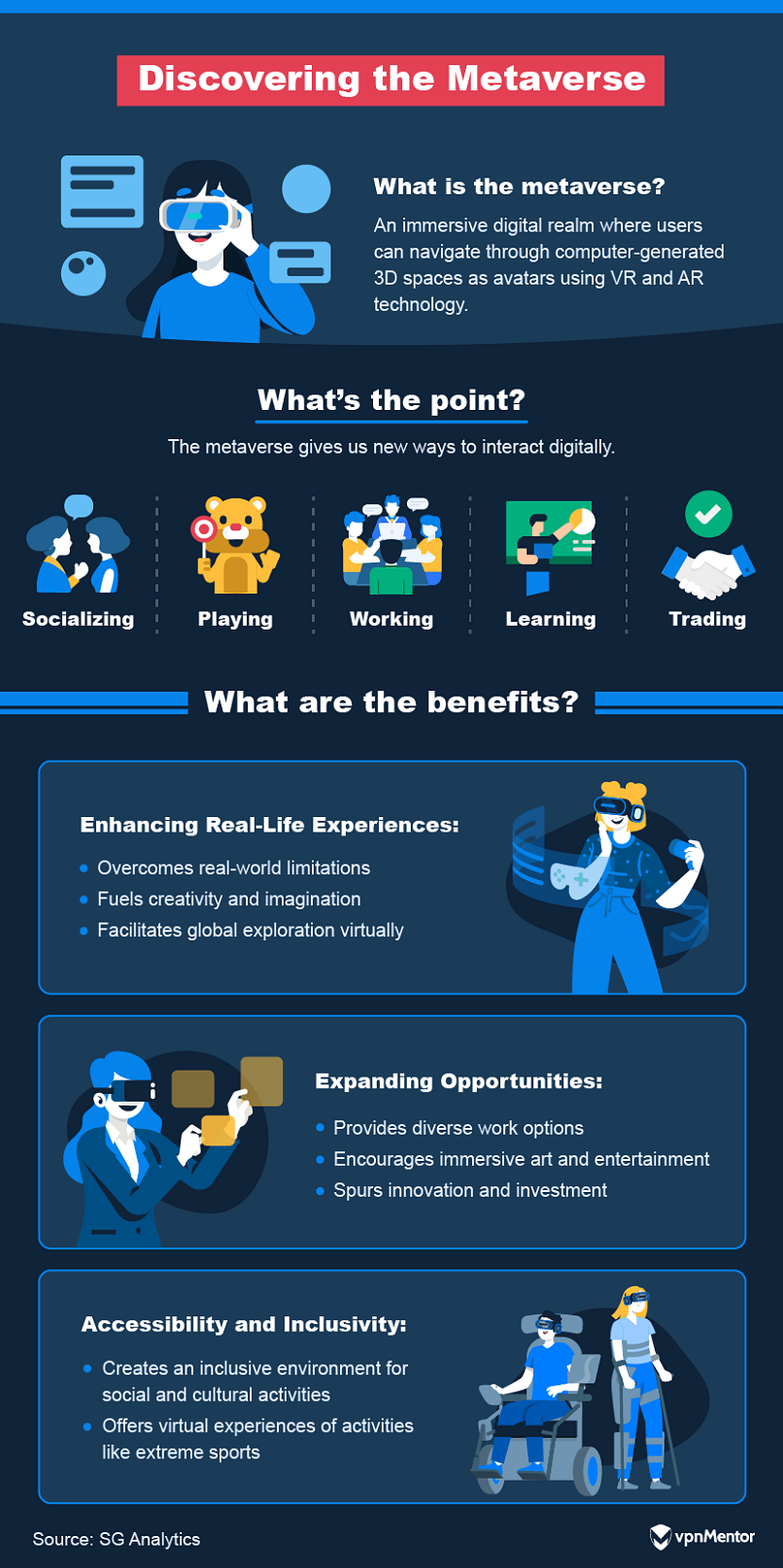
Picture the metaverse as a sprawling, virtual-reality landscape. It’s a computer-generated 3D space where you, represented by your unique avatar, can wander around, mingle with other avatars, and take part in a variety of activities.
Using VR and AR technology, you’ll step into a universe that’s rich, interactive, and multi-dimensional. The idea is that this will allow you to forge connections and have experiences that are more natural, intuitive, and lifelike.
Rather than simply scrolling on a website or social media, the metaverse will allow you to dive deep into experiences that engage all of your senses. Although we don’t know the exact details of how we’ll operate and interact within it, we’ve already started on the path to forming this new world.
Virtual reality (VR) video games, meeting rooms, classrooms, social events, and other VR applications are paving the way to the metaverse of the future. These dimensions of the metaverse are making the concept less sci-fi fantasy and more of a tangible reality for our digital lives.
The History of the Metaverse

Before we delve deeper into the concept of the metaverse, let's take a step back and explore the technological milestones that have paved the way to this new digital frontier.
In the early 19th century, Sir Charles Wheatstone’s research on stereoscopic vision laid the foundation for the optical technology found in VR headsets. Although this was a groundbreaking development, there was still a way to go before we started taking steps towards the metaverse.
More than 100 years later, the Philco Corporation would create Headsight, the first motion-tracking head-mounted display. Another breakthrough followed in 1962, when Sensorama, Morton Heilig’s multi-sensory simulator, allowed users to experience an immersive virtual motorcycle ride.
Augmented reality started to emerge towards the end of the same decade. Computer scientist and internet pioneer Ivan Sutherland developed the Sword of Damocles, the first VR headset and an early form of AR, in 1968.
Ten years later, we’d get MUD1, considered the oldest virtual world in existence. This text-based game introduced shared virtual spaces and laid the groundwork for what was to come.
The development of digital worlds and VR started to take off through the ’80s and ’90s. Technology company VPL Research released the first consumer-ready VR goggles and gloves in 1988. Then, in 1992, Neal Stephenson’s Snow Crash introduced the term “metaverse” into the English lexicon.
Once we had a name for this budding new world, things really got interesting. Virtual chat rooms, massively multiplayer online role-playing games (MMORPGs), and other platforms steadily emerged throughout the early 2000s. Arguably one of the most influential of these was Second Life, which introduced user-created content and a virtual economy in a virtual world.
By 2009, Bitcoin had emerged as the first decentralized digital currency. The principles of blockchain, ownership, and peer-to-peer transactions that Bitcoin—and the metaverse—is built on would catapult us into the next stage of digital world development.
The 2010s would see the rise of VR, AR, and blockchain, with Meta (then Facebook) acquiring Oculus in 2014 and releasing its first consumer VR headset two years later. Another important development took place in 2018, when Axie Infinity introduced play-to-earn mechanics in its virtual worlds.
As we reached the second decade of the 21st century, things began to progress even more quickly.
Decentraland launched on the Ethereum blockchain in 2020, providing a decentralized platform for virtual environments. In 2021, Facebook announced that it would change its name to Meta, evidence that it would focus on VR and AR developments. Microsoft also introduced Mesh, a mixed reality (MR) platform.
Most recently, in 2023, Apple entered the mixed-reality headset market with the release of Apple Vision Pro.
What Does the Metaverse Look like Today?
The metaverse industry is currently a bit like a digital Wild West. Various vendors are staking their claim and what’s emerging are multiple virtual worlds; each with their own unique style and selling points. A factor that’s affecting how quickly the metaverse can be fully realized.
This, in turn, is affecting how people currently view and use these platforms. Only about 0.05% of the world’s population uses the metaverse each month. Most users access The Sandbox, Horizon Worlds, and VRChat to play games, hang out with friends, and work.
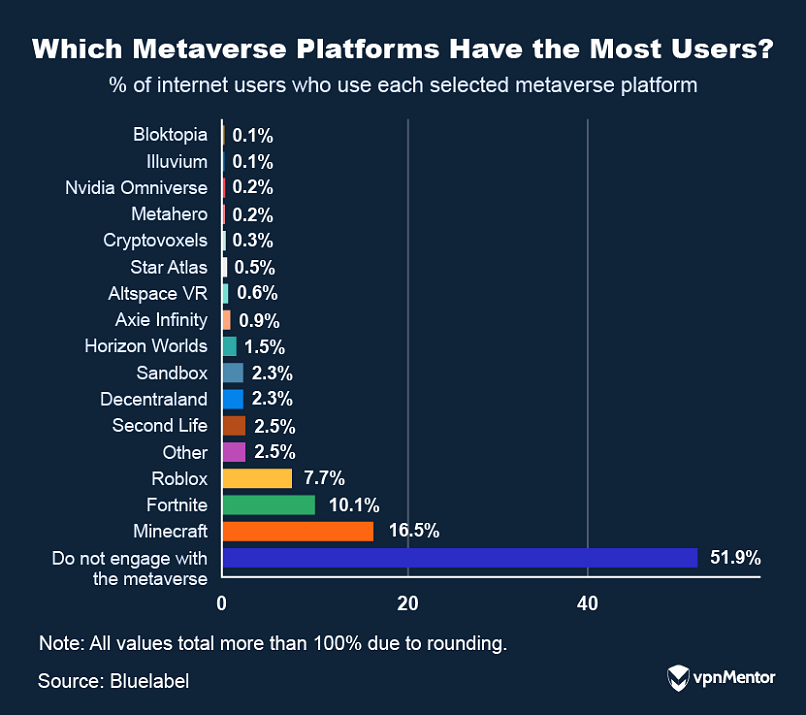
Businesses believe that it will take at least five years for these worlds to become widely used by consumers. Companies are intended to be the major driving force behind building immersive metaverse environments, so this is likely also affecting the rate of development.
Besides the metaverse’s perceived utility, there are also challenges around giving users a fully immersive experience, which is the proposed hallmark of these digital worlds.
Although the tools for exploration (like VR and AR devices) are already in place, we still have a way to go before the metaverse we access looks like the one tech leaders and companies are proposing.
The graphics and functionality needed to ensure that users can become fully immersed in these digital worlds require a massive amount of computing power. Plus, interoperability requires buy-in from vendors who are creating these virtual spaces to ensure they develop and use compatible technologies.
We’re also facing plenty of other challenges, like accessibility and issues around property rights, governance, and value transfer across different virtual spaces. We explore these in more detail in the “Challenges Presented by the Metaverse” section below.
What Could the Metaverse Look like in the Future?
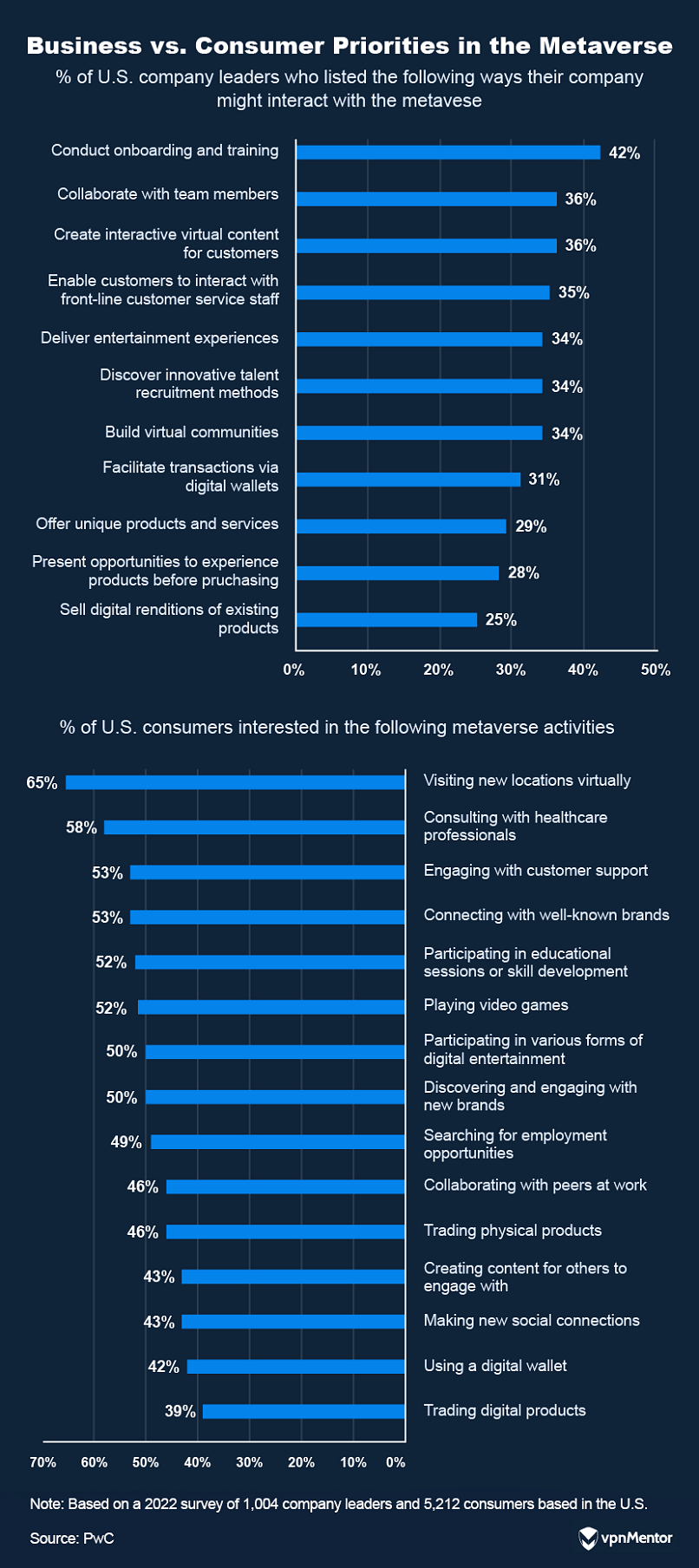
The metaverse is set to evolve dramatically from its current, fragmented state over the next five to 10 years. Metaverses will likely be more unified and more accessible, overcoming the present challenges of limited interoperability and low-fidelity experiences.
For consumers, the hope is that the metaverse will allow us to visit new places, access healthcare, interact with brands, become more educated, and buy and sell goods.
Businesses aim to meet these expectations by creating spaces where their customers can interact with them, they can create communities, and provide entertainment. The intention here is to offer fully immersive virtual social gatherings, educational classes, and even digital workspaces that are as engaging and interactive as their physical counterparts.
This expansion will be supported by the continued development and integration of VR and AR technologies as well as increased computing power to enhance the depth and realism of these virtual spaces. What’s more, interoperability will allow you to move effortlessly from one virtual space to another, creating an even more seamless experience.
Ultimately, it’s envisioned that this unified and technologically advanced digital world will offer a space where everyone, regardless of their location or device, can connect, learn, and play together in a cohesive and richly detailed environment.
Technologies Shaping the Metaverse
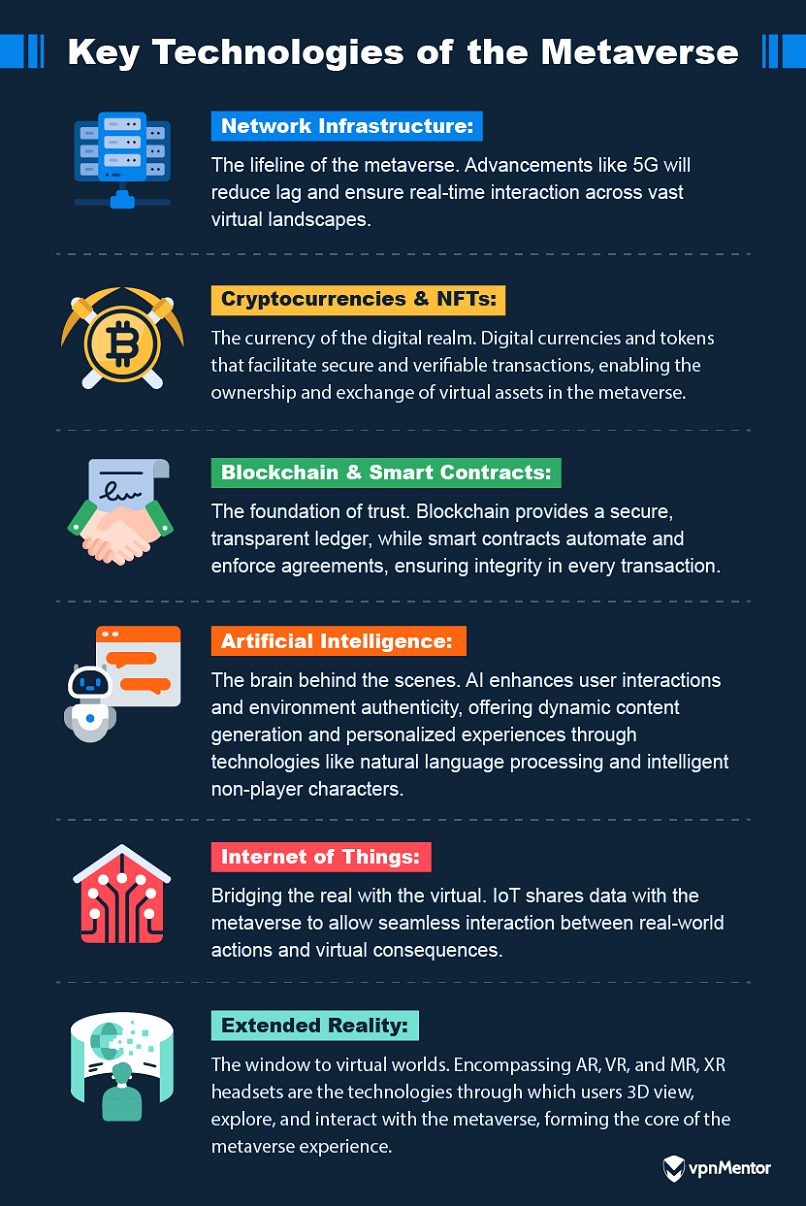
The metaverse is an evolving digital universe, shaped by cutting-edge technologies. To make it easier to understand how the underlying technologies power the metaverse, we’ll use the example of PixelVerse, a fictional digital world where the full potential of metaverse technologies comes to life, throughout this section.
Let’s look at how these technologies enable unique interactions within virtual worlds.
Essential Network Infrastructure
5G
The fifth generation of mobile network technology, characterized by higher internet speeds, reduced latency, and increased network capacity compared to previous generations.
Edge Computing
A computing framework that processes data closer to its source, enhancing response times and reducing bandwidth use. This contrasts traditional cloud computing, where data must be transferred to distant centers for processing.
Robust network infrastructure, including technologies like 5G and edge computing, is the foundation of the metaverse. This advanced setup enables users from across the globe to connect in real time, ensuring a seamless virtual experience.
The high-speed internet and efficient data processing minimize latency and optimize bandwidth usage, which are vital for maintaining high-quality visuals and interactions as the user base grows and the virtual world evolves.
Imagine being in PixelVerse, talking to a friend from Japan. If your internet is too slow, you’re left with delayed responses and disjointed interactions, akin to the frustrating lags you might have encountered in online meetings as we currently know them. This lag could cause you to miss crucial parts of the conversation or disrupt the flow, diminishing the immersive experience.
The robust network infrastructure underlying metaverses is designed to prevent such scenarios, ensuring that every virtual interaction feels as seamless and real-time as face-to-face communication.
Web 3.0 Technologies
Web 3.0
A new paradigm in cyberspace that emphasizes user privacy, data ownership, and interoperable services.
Web 3.0 is the third evolution of the internet; i.e. the interface that allows users to access documents, applications, and multimedia online. It’s envisioned to be a decentralized version of cyberspace, offering users more control, security, and connection.
This concept is crucial for understanding the underpinnings of the metaverse and the technologies that enable it.
In PixelVerse, the principles of Web 3.0 come to life. For instance, when you purchase that digital NFT artwork using cryptocurrency, you're engaging with a decentralized system typical of Web 3.0.
These technologies, which we'll explore in more detail in subsequent sections, are what make dynamic, user-driven experiences like those in PixelVerse possible. This marks a significant shift from the more centralized and corporate-controlled Web 2.0.
Blockchain, Smart Contracts, Cryptocurrency, and NFTs
Cryptocurrency
Digital currencies that use cryptography to enable secure transactions, operating on decentralized networks rather than under central authority control.
NFT
Non-Fungible Tokens are unique digital assets verified on a blockchain, representing ownership of specific digital or physical items.
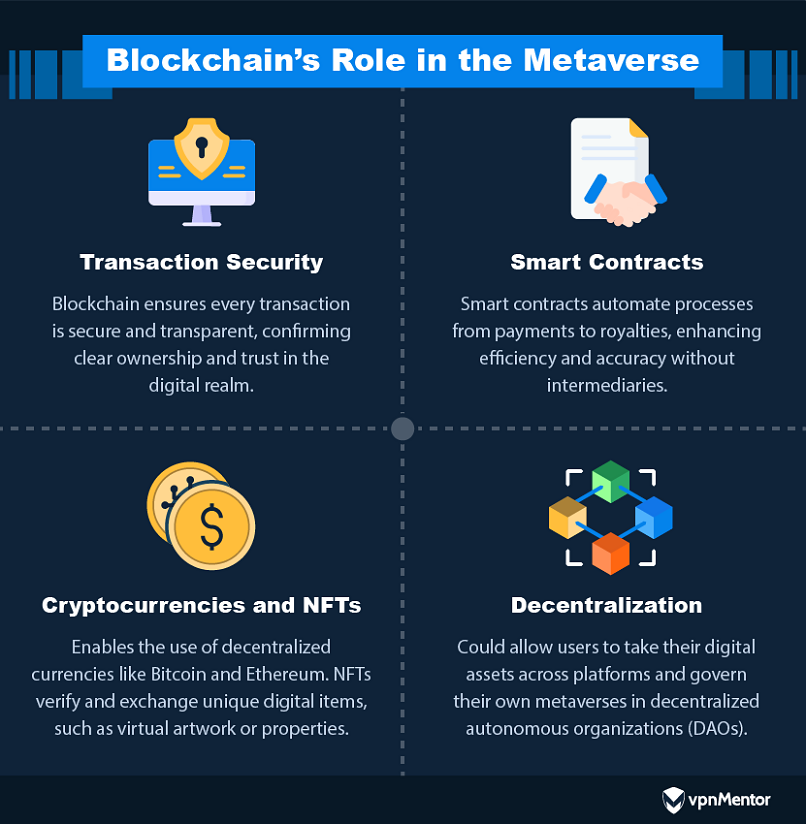
Blockchain technology and smart contracts are at the core of the metaverse’s transaction system.
Blockchain acts as a decentralized ledger, recording transactions securely and transparently. Smart contracts, which operate on this blockchain infrastructure, are automated agreements. They execute the terms of a contract automatically when predefined conditions are met, ensuring accuracy and adherence to the agreement.
The integration of blockchain and smart contracts is essential for facilitating transactions with cryptocurrencies and NFTs in the metaverse.
Cryptocurrencies, such as Bitcoin and Ethereum, are used for a variety of transactions, from simple asset purchases like digital artwork to more complex activities like participating in virtual real estate auctions. They represent a shift towards more user-driven financial interactions in virtual environments.
NFTs play a pivotal role in establishing the ownership of unique digital items, such as virtual land or collectibles. In the metaverse, NFTs act as a means to authenticate and trade these digital assets. Their legal status is still being defined in the physical world.
Let’s consider PixelVerse for a minute. To brighten up your home in this metaverse, you purchase a digital painting (an NFT) for your virtual mantle.
You opt to use Bitcoin for the transaction. This purchase, and the transfer of ownership, is recorded on the blockchain as an NFT. A smart contract automatically manages the transaction, ensuring that both the digital artwork and cryptocurrency exchange hands securely and verifiably.
This interplay between blockchain, smart contracts, cryptocurrencies, and NFTs ensures indisputable ownership and a smooth, trustworthy transaction process within the metaverse.
Artificial Intelligence
Natural Language Processing (NLP)
A subfield of AI that focuses on enabling machines to understand, interpret, generate, and respond to human language. This technology is required for tasks such as language translation, sentiment analysis, and conversational interfaces like chatbots.
Non-player characters (NPCs)
Automated, digital characters that are programmed to interact with users, perform specific actions, or enhance the virtual environment's realism and interactivity.
Artificial Intelligence (AI) significantly enhances user experience in the metaverse. It integrates into avatars, enabling them to mimic real-world gestures and emotions in real time.
For example, when you smile or frown while wearing a VR headset, AI interprets and reflects these expressions on your avatar, fostering more lifelike interactions.
Natural Language Processing (NLP)
NLP is a crucial AI component that enables computers to understand and generate human language.
It uses algorithms to interpret speech or text, facilitating natural interactions between users and the virtual environment. It can also break down language barriers, allowing you to communicate with other users from around the world through the use of real-time translation.
In PixelVerse, when your friend from Japan visits your virtual home, you can both speak your respective mother tongues and NLP will seamlessly translate the conversation so that you can chat without any delays or misunderstandings.
Non-Player Characters (NPCs)
AI makes NPCs in the metaverse more dynamic and realistic to transform NPC encounters from scripted events into unique, evolving experiences.
Imagine you’re exploring a bustling virtual marketplace in PixelVerse. As you interact with various NPCs, AI brings these characters to life with dynamic responses and realistic behaviors. One NPC, an AI-driven shopkeeper, engages you in a conversation about a rare digital artwork you’re interested in.
Thanks to NLP, the shopkeeper understands your queries and responds naturally, even negotiating the price in a human-like manner. This conversation occurs seamlessly, despite your different languages, as NLP translates everything in real time, allowing for a fluid and intuitive interaction.
As you move through the marketplace, other NPCs react to your presence and previous interactions. An AI artist you spoke to earlier remembers your interest in abstract art and suggests a new piece they’ve just created.
Internet of Things
Internet of Things (IoT)
A network of physical objects—or things—embedded with sensors, software, and other technologies to connect and exchange data with other devices and systems over the internet.
The IoT links the metaverse with the real world by extracting data from the real world and implementing that within the metaverse.
IoT devices in the metaverse, particularly extended reality (XR) devices, translate physical inputs into actions within the virtual world. These devices can also send personal data, like biometric identifiers, back to the metaverse, tailoring the user experience.
Moreover, IoT technology enables you to control real-world devices from within the metaverse. This is vital for creating synchronized environments where changes in the real world, like weather, are mirrored in your virtual space.
Imagine a day in PixelVerse: The sun is shining and you opt to spend time with friends in your virtual garden. As you enjoy the virtual sunshine, the weather shifts, and it starts to rain.
When you log out of PixelVerse and remove your VR headset, you find the real world has also transitioned to rain, perfectly synchronized with your virtual experience. That’s thanks to IoT technology.
Spatial Computing
Extended Reality (XR)
XR, also referred to as spatial computing, is an umbrella term that encompasses AR, VR, and MR. It represents a broad spectrum of technologies that merge digital and physical worlds to enable immersive experiences.
Augmented Reality (AR)
AR involves overlaying digital content onto the real-world environment to enhance it. Think Pokémon GO, where digital objects are added to the real world but not integrated into it.
Virtual Reality (VR)
VR creates a completely immersive environment, transforming sensory inputs to transport users to a fully digital world. This is achieved through devices like head-mounted displays and motion controllers, as exemplified by the virtual worlds in The Matrix.
Mixed Reality (MR)
MR blends the real world with digitally created content, allowing both to coexist and interact in a unified experience. Virtual objects in MR interact with the real world in a realistic manner, such as being occluded by physical objects and reflecting real-world lighting conditions.
Spatial Computing (SC), a term often used interchangeably with XR, plays a crucial role in the metaverse by enabling the merging of virtual and physical realms. This technology, encompassing VR, AR, and MR, enables a seamless blend of digital and real-world interactions, enhancing the overall user experience.
Imagine you’re exploring a virtual mall in PixelVerse. You spot a pair of jeans you’ve been eyeing. Using SC, you enter the shop for a virtual try-on. The experience is incredibly lifelike: you can see how the jeans fit and feel on your avatar, replicating the experience of trying on clothes in a physical store.
While in the shop, SC allows you to interact with digital objects like the jeans as though they were tangible. You can pick them up, examine them, and place them back down, and your physical actions will be mirrored in the virtual environment.
This interaction is not just about visual perception; it’s about engaging with the virtual world in a way that feels as natural and intuitive as the real world.
Key Features of the Metaverse
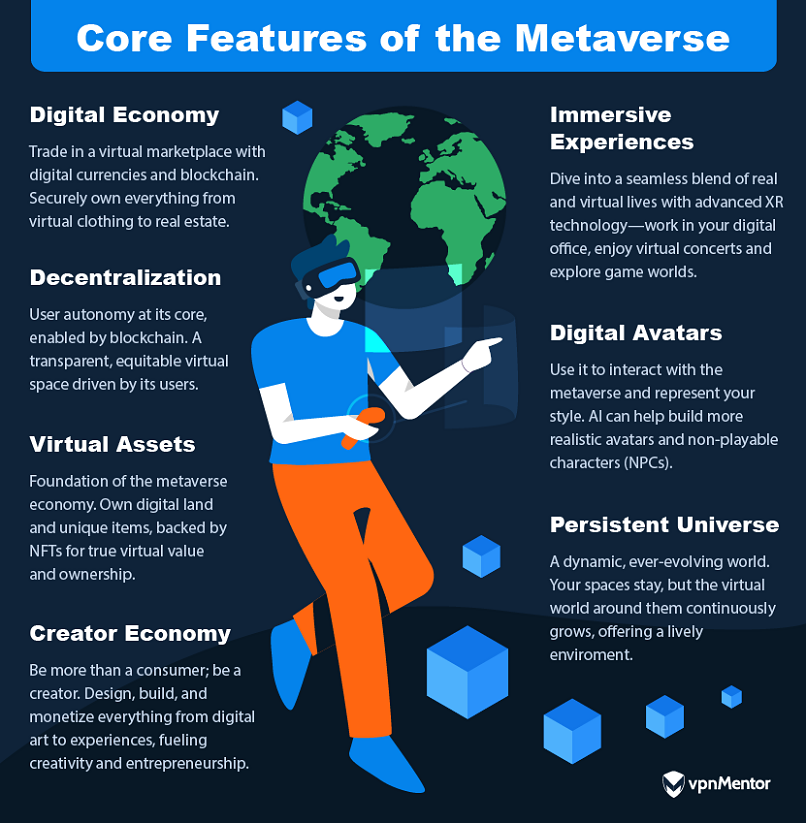
The metaverse’s key features range from immersive experiences that integrate work and play to a burgeoning digital economy, and the innovative governance models that empower its users. Each aspect plays a crucial role in making the metaverse a rich, multi-dimensional experience.
Immersive Experiences
The metaverse aims to offer users more immersive experiences than just clicking around on a website.
Emerging technologies that aim to make interacting with virtual content more realistic, like XR, are key here. Combining work, education, and entertainment into a single digital space is also essential to driving these experiences.
In PixelVerse, you could work from a virtual office in the morning, followed by a lunch break on the grass in front of a digital twin of the Eiffel Tower in Paris. After work, you could seamlessly dive into a virtual game, teaming up with friends to battle aliens and fend off an invasion of Earth.
This level of immersion, where your experiences are vivid and interactive, goes beyond traditional video-watching, making you feel like you’re truly part of these worlds. The ability to instantly navigate between different domains—whether they are work, play, or social—within a single platform promises a user experience not currently available on the internet.
Digital Avatars
In the metaverse, digital avatars are more than just profile pictures, they’re personalized 3D characters that represent you in this virtual space. They essentially enable you to express your identity and engage in a wide range of activities just as you would in the physical world.
For instance, you can customize your avatar to reflect your personal style, from the clothes you wear to unique accessories. You can also attend a virtual concert, participate in a meeting, or explore an art gallery in the metaverse using your avatar.
Artificial intelligence plays a pivotal role in this immersion. It ensures that the avatars not only look like their real-life users, but also mimic their expressions and gestures to create a more authentic and engaging experience in the metaverse.
Persistent Universe
The concept of a persistent world is also integral to the metaverse experience. Unlike traditional online games, the metaverse is always ‘on’, meaning the world continues to evolve even when you’re not logged in.
For example, in your PixelVerse home, while it remains as you left it, the world around it evolves—friends might drop messages, events may occur, and landscapes can change, reflecting a dynamic, ever-changing virtual space.
The Digital Economy
The digital economy allows users to engage in unique activities such as buying, selling, trading, and creating digital assets.
As we’ve already mentioned, blockchain technology, smart contracts, cryptocurrencies, and NFTs are critical elements of this economy. They enable secure, automated transactions and digital marketplaces where virtual goods can be exchanged.
Within the metaverse, the digital economy is expanding rapidly, driven by increasing user engagement and technological advancements. This growth represents a shift in how value and ownership are perceived in the digital age.
Virtual Assets
Virtual assets, including digital land, play a pivotal role in the metaverse’s digital economy.
Owning these assets, which are backed by NFTs, is akin to holding a piece of digital property. In the metaverse, these assets are not just limited to land but also include buildings, businesses, and other unique creations.
For example, upon entering PixelVerse, you find the need for a virtual home. Let’s say you choose a quaint digital house, nestled in a vibrant community. To personalize this space, you might purchase a digital artwork, perhaps an NFT of a stunning landscape, placing it above your virtual mantle.
This process of selecting and buying virtual items for your home in the metaverse not only adds personal flair to your digital space, but also reflects the growing importance and value of virtual assets in the digital economy.
The value of these virtual assets is influenced by their developmental potential and market demand, similar to real-world assets. In some metaverses, the limited supply of assets, such as finite plots of land or unique items, directly impacts their value.
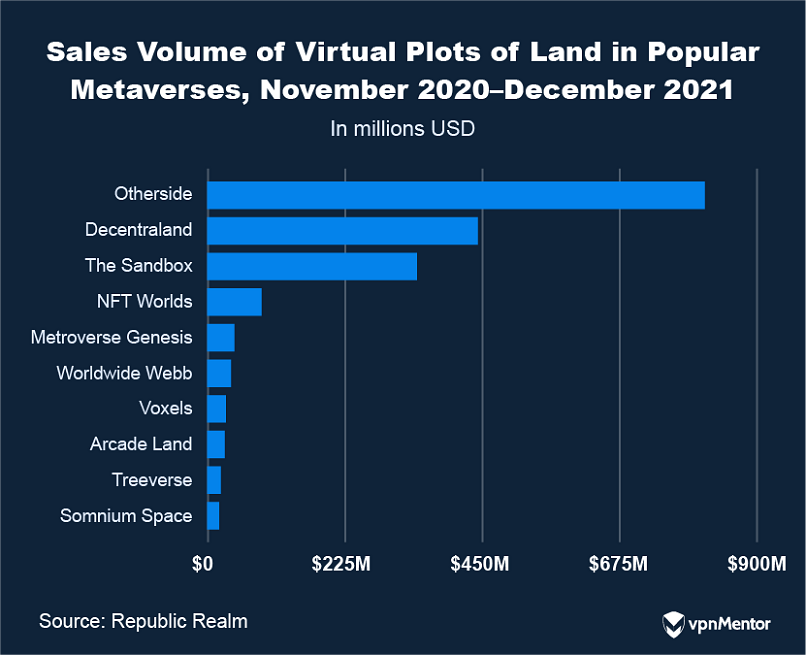
Decentralized Asset Holding
Decentralized asset holding, facilitated by blockchain technology, changes how digital assets are managed and transferred.
Blockchain enhances the security and transparency of these transactions and facilitates the fluid transfer and portability of assets. This capability is crucial for achieving interoperability among different virtual spaces.
For example, consider a scenario where you’ve purchased a unique digital sweater for your avatar in PixelVerse. Thanks to the blockchain, you can easily take and wear your sweater to another metaverse platform.
This interoperability, enabled by blockchain’s asset portability, allows your digital possessions to move with you, broadening their utility and value.
Decentralized Governance
Decentralized governance, which is all about giving power to the users, is also a key aspect of the metaverse.
This approach, also powered by blockchain, involves community-driven decisions through structures like decentralized autonomous organizations (DAOs). Here, users are empowered to make key choices about how the virtual world operates as a collective.
For example, in PixelVerse, the community can vote on new features or changes to the virtual environment. Like attendees getting to decide on the theme for a large-scale virtual event or choosing to introduce new construction rules in PixelVerse.
This decentralization ensures that a metaverse evolves according to the preferences and needs of its community, making it a truly collaborative space.
Creator Economy
The creator economy within existing metaverses is evolving rapidly, offering users the opportunity to not only consume but also create and monetize content.
In these digital realms, individuals can engage in activities like buying, selling, trading, and even crafting assets, including the development of unique in-world experiences.
In Pixelverse, you can create a mini-game, a unique digital adventure that other users can explore and play. This mini-game, minted as an NFT, serves as an entertaining experience and a valuable asset for you, its creator. As players engage with this game, you earn revenue, either through entry fees or in-game purchases.
Challenges Presented by the Metaverse
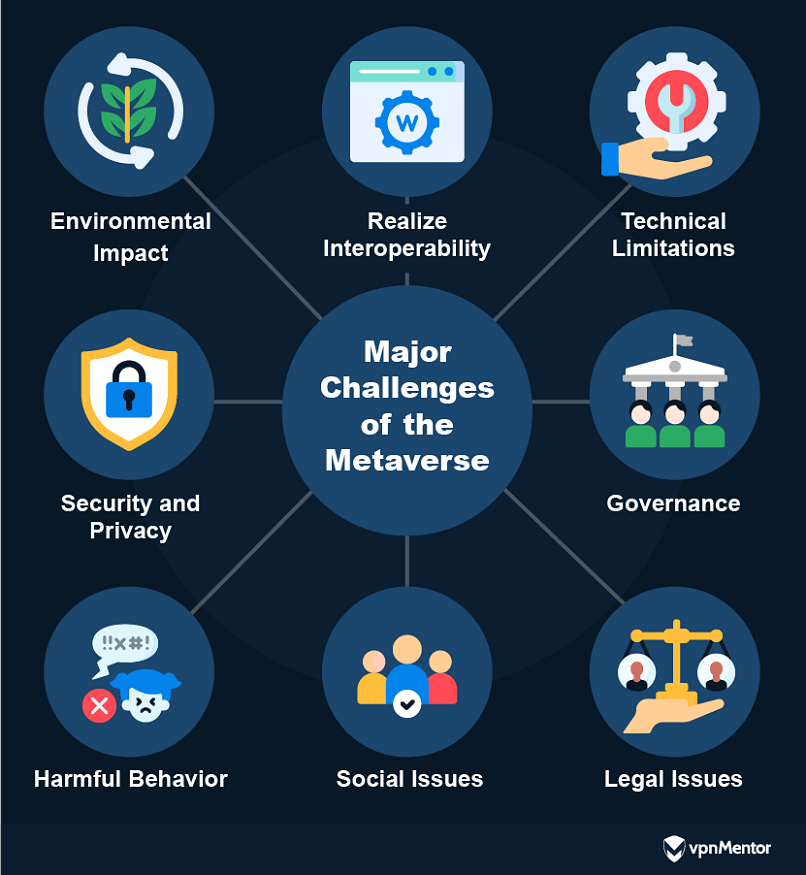
There are a range of challenges presented by people beginning to operate in the metaverse. Let’s take a closer look at some of the major issues and their potential effects.
Interoperability
Interoperability stands as a fundamental challenge in the metaverse’s development. This concept involves the ability of different platforms to interact seamlessly, which is crucial for the transfer of avatars, digital assets, and currency across virtual environments.
However, many existing platforms operate in isolation, forming digital silos that limit users’ ability to freely move and use assets across different metaverse spaces.
Achieving interoperability is particularly challenging due to the need to align diverse governance models and legal frameworks across countries and digital worlds to facilitate this seamless interaction.
Network and Server Capabilities
Another significant hurdle in the development of the metaverse is the strain on networks and servers. As we design the infrastructure for the metaverse, it’s crucial to prepare for a future where potentially millions of users simultaneously engage in these environments.
The high volume of real-time data processing necessary for a fully immersive metaverse experience often results in lag, which significantly reduces the quality of user engagement.
Governance
A critical issue in the metaverse is the lack of established legal governance. Currently, there are no specific laws governing these virtual spaces. This raises concerns about how to effectively manage and regulate aspects like digital property rights, user conduct, and data security.
Without clear legal frameworks, the metaverse risks becoming a lawless space, susceptible to misuse and unethical practices.
Centralized models, like Meta’s Horizon Worlds, offer streamlined experiences but raise concerns about censorship and monopolistic control, which could potentially lead to ethical issues. Decentralized models, such as Decentraland, allow for greater user control, but can suffer from decision-making inefficiencies and risks of majority rule overshadowing minority voices.
Determining which governing body should police the metaverse is another complex issue. Given the difficulties that big tech companies face in regulating their platforms, relying solely on them for oversight in the metaverse may not be the best solution.
This situation calls for the development of new governance models that may involve collaboration between tech companies, users, legal experts, and potentially new regulatory bodies designed specifically for the metaverse environment.
Legal Issues
The legal landscape of the metaverse is complex, especially in relation to copyright laws and the rights attached to virtual assets. One major issue is unauthorized reproduction of digital assets, which often results in copyright infringement.
Imagine a digital artist in the metaverse starts creating and selling NFTs of Van Gogh’s Starry Night. Despite being tokenized as NFTs, this act could infringe upon the copyrights held by the real-world owners of the original artwork, who may then have legal grounds to challenge such reproductions in the metaverse.
The role of NFTs complicates this legal framework further. These tokens are commonly perceived as proof of ownership for digital assets, but they only confer rights to the tokenized version, not the actual intellectual property it may represent. This can lead to misunderstandings among NFT owners.
Someone who purchases an NFT of a digital sculpture may believe they have complete rights over the sculpture’s design. However, in reality, they only own the specific digital version, not the design itself. This could lead to legal disputes if the NFT owner attempts to reproduce or modify the work without permission.
Social Issues
Essential tools like high-quality VR headsets and high-speed internet are costly and not globally accessible. This situation risks widening the digital divide; in other words, the gap between those who can afford and access these technologies and those who can’t.
Potentially limiting the participation of less affluent individuals in the metaverse could result in social inequality being more pronounced in the digital world.
While the cost of VR technology is expected to decrease over time, the current economic barriers suggest that the metaverse may initially be more accessible to those with financial means. Proactive efforts to provide affordable hardware and expand internet accessibility are crucial to avoid making the metaverse an exclusive domain.
In some versions of the metaverse that are currently operational, efforts have also been made to offer more intuitive interfaces that aim to serve not just tech-savvy users but also those who may not be as familiar with digital environments.
The ideal metaverse would feature design elements catering to disabled individuals—for example, seamless audio descriptions of what’s going on around visually impaired users—though this is still an area of ongoing development.
Potential Misuse and Harmful Behavior
The metaverse, with its immersive and engaging platforms, presents unique risks for unethical and harmful behavior, notably through the creation and use of avatars.
While these avatars enable diverse self-expression, representing various ethnicities, genders, or identities, they also open avenues for misuse, such as cultural appropriation or perpetuating harmful stereotypes. This can have significant social repercussions.
The realism of the metaverse can also amplify the effects of digital harassment, like cyberbullying, hate speech, or unwanted sexual advances. Researchers have noted that experiencing harassment in the metaverse can closely mimic real-world traumas due to its immersive and immediate nature.
Consider a recent case where a woman was virtually attacked by a group of avatars. She reported feeling frozen during the incident and struggling to remember how to use her controllers to exit the situation, highlighting the distressingly realistic nature of such encounters in the metaverse.
The highly immersive nature of the metaverse also brings safety concerns, especially for vulnerable users like children. These users, who aren’t necessarily familiar with online safety practices, might be more susceptible to manipulation or exploitation due to their developing cognitive and emotional capacities.
Security and Privacy
The metaverse’s approach to security and privacy encompasses more than traditional data protection. Users face unique cyber threats, especially concerning their digital wallets and the assets they hold, like NFTs.
Financial fraud is a growing concern in the metaverse due to the high volume of e-commerce transactions, drawing criminals seeking to exploit these digital spaces. In addition to financial attacks, privacy is a major concern in the metaverse.
The extensive data collection capabilities of metaverse platforms is seen as a major problem. Technologies like VR headsets collect highly personal information, such as physical characteristics, eye movements, posture, pupil dilation, and other behavioral data.
This level of detail, which will only become more intricate as technology advances, opens the door to unprecedented privacy challenges. Companies could use this data for targeted advertising, while unauthorized third-party access to such sensitive information poses significant risks for enabling crimes like identity theft.
The potential future capabilities of these technologies, like assessing mood or mental health status, underscore just how critical robust privacy safeguards are.
Users’ data in the metaverse is not just personal; it’s intimately linked to their physical and psychological attributes. The misuse of such data could have far-reaching and severe consequences, placing individuals in a vulnerable position.
Environmental Impact
The metaverse brings with it significant environmental concerns, particularly in terms of energy consumption and e-waste production.
These expansive digital worlds necessitate more data centers, VR hardware, and robust computing systems, coupled with low latency and high computational power. This combination leads to considerable energy demands and increased carbon emissions.
Researchers estimate that if 30% of gamers transition to cloud gaming platforms by 2030, we could see a 30% increase in carbon emissions. A projection from Intel suggests that achieving a truly immersive metaverse accessible by billions in real-time would need computational efficiency to increase by 1,000 times.
The lifecycle of metaverse-related hardware, including VR/AR headsets, PCs, and gaming consoles, also affects its environmental footprint.
From the sourcing of equipment to its eventual disposal, these devices not only consume energy during usage (with VR headsets averaging around 0.5 kWh an hour) but also add to e-waste and raise questions about sustainability.
The Metaverse’s Use Cases
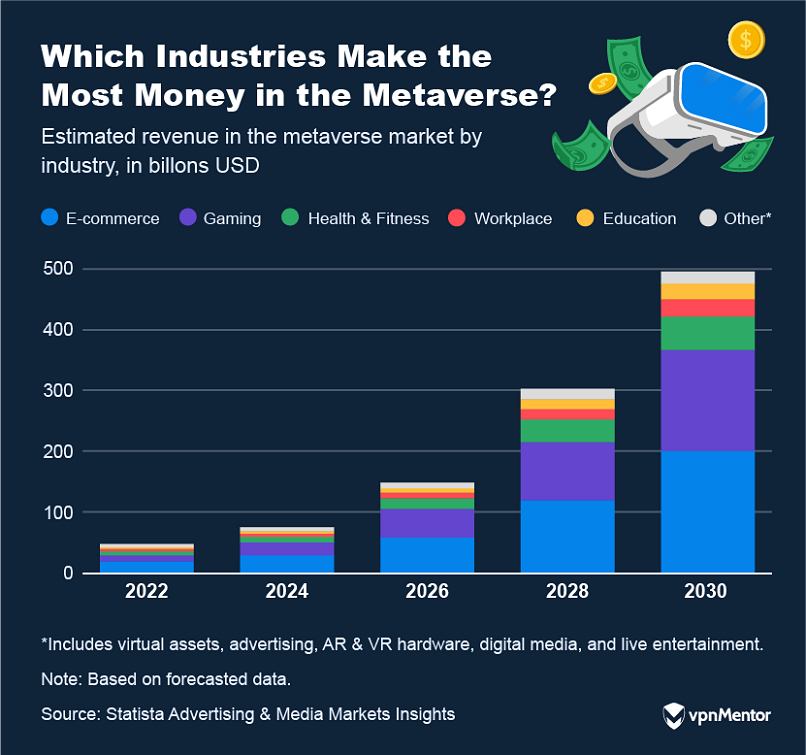
Though still in its early stages, the metaverse is rapidly gaining traction across various sectors. Forecasts predict that the global metaverse market will reach $145 billion in 2026, with estimations showing a potential surge to $490 billion by 2030. Less conservative forecasts predict the Metaverse could be valued as high as $937 billion by 2030.
This projected growth reflects the strong belief in the metaverse’s future significance and suggests a burgeoning market as its applications widen and user engagement increases.
Entertainment and Gaming
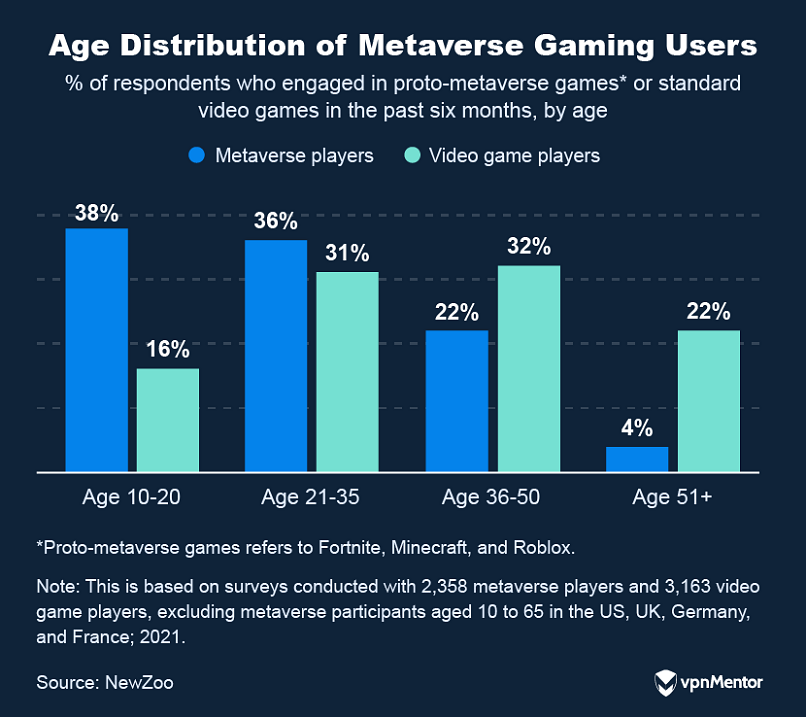
In the realm of entertainment, the metaverse offers far more than virtual concerts and events. It opens up a world where you can attend virtual art exhibitions, participate in interactive theater performances, or join in on immersive educational experiences.
These activities provide a level of engagement and interaction that traditional internet or real-life settings cannot match, thanks to the advanced VR and AR technologies.
When it comes to gaming, the metaverse offers distinct experiences. Aside from the traditional multiplayer games, it brings innovative activities, like playing a round of VR golf with friends. These experiences are enhanced by the metaverse’s immersive nature, allowing players to feel as if they are truly inside the game.
Then there are blockchain-based games, which represent a unique subset within the gaming universe. These games enable an economic system where players can buy, own, and trade in-game content like wearables or new experiences.
Blockchain allows for an evolving economic landscape where the value of in-game items can rise and fall based on demand. This stands out from traditional gaming models, where users purchase downloadable content (DLC) for a fixed price that’s determined by the makers of the game.
There’s another layer to blockchain gaming: play-to-earn models. Games like Axie Infinity, Plants vs Undead, and Farmers World are all great examples of this genre.
In these games, playing equates to minting cryptocurrencies or NFTs, which players can keep, trade, or sell for a profit. This aspect introduces a real-world economic element to gaming, where the rarity and demand for certain items determine their value.
Looking ahead, the metaverse is poised to further diversify entertainment and gaming. We can expect experiences that are currently unimaginable. Users could potentially engage in activities ranging from interactive storytelling to personalized create-your-own-adventure experiences, all enhanced by advancements in AI, VR, and AR.
With the blockchain gaming market projected to reach $65.7 billion by 2027, we’re seeing just the beginning of a revolution in how we play, interact, and transact in virtual worlds.
The metaverse, with its unique blend of technology and creativity, is set to become a compelling platform for players and brands, reshaping our understanding of digital experiences.
Virtual Exploration and Tourism
In the metaverse, virtual exploration and tourism present unique opportunities for users to experience both real and computer-generated environments in unprecedented ways. This potentially opens new revenue streams for businesses and a sustainable alternative to traditional tourism, which could help to preserve real-world historical sites.
Currently, the metaverse serves as a platform for various virtual tourism experiences. Users can virtually travel to locations like Venice, Seoul, the ancient city of Pompeii, the Great Pyramids of Giza, or the Australian Outback.
As technologies like spatial computing advance, these virtual spaces are expected to become even more immersive and interactive. Tools like Google Earth VR could take this a step further by digitally recreating real-world landmarks, seamlessly blending virtual and real-world experiences.
Users could virtually visit digital twins of real-world or ancient places that are overlaid with interactive historical facts and narratives. This evolution in virtual tourism will not only provide educational value, but could make global landmarks and experiences more accessible to a diverse audience.
Work and Education
The metaverse could revolutionize the realms of work and education. Companies might significantly reduce expenses by minimizing the need for physical office space, while educational institutions could offer more dynamic and engaging online learning experiences.
Tools like Microsoft Mesh, for instance, are enabling the creation of virtual offices where colleagues can collaborate at a digital boardroom table or engage collectively at a digital whiteboard. This has the potential to make online collaboration much more engaging and efficient.
In the educational sphere, platforms like ENGAGE and ClassVR are combating the tedium of traditional video conferencing. They replace 2D interactions with 3D classroom environments, making remote learning more immersive and interactive.
Looking ahead, the metaverse is set to incorporate advanced features like NLP-powered real-time multilingual translation, which could dismantle language barriers and facilitate global collaboration. This would be supported by edge computing, which could enable efficient real-time data sharing and interactions.
For example, in PixelVerse, students could engage in virtual explorations, such as delving into marine biology with experts in virtual oceanic environments. In the corporate sector, businesses host virtual hackathons, where global teams collaborate within a secure, virtual environment to solve complex problems.
Healthcare, Fitness, and Wellness
The metaverse’s diverse applications have the potential to enhance patient care, increase access to exercise, and promote overall wellness in innovative ways.
In healthcare, the metaverse can facilitate:
- VR exposure therapy: Devices like Oculus Rift can be used to help patients safely confront fears or stressors.
- Real-time monitoring of vital signs: XR technology can enhance the quality of remote consultations by providing live vital readings.
Fitness and wellness in the metaverse extend beyond physical health. Some developers are creating new tools and devices that can help users improve their mental well-being.
Companies like Peloton are investigating ways to make online workouts more interactive and social. Users can participate in a wide range of sports and exercise routines from their living rooms.
Virtual wellness spaces can offer access to guided meditation sessions, yoga classes, and wellness workshops, all in immersive, calming virtual environments.
AI-moderated support groups within the metaverse can provide a safe and supportive space for discussing and addressing various health concerns, fostering a sense of community and shared experience.
Industry
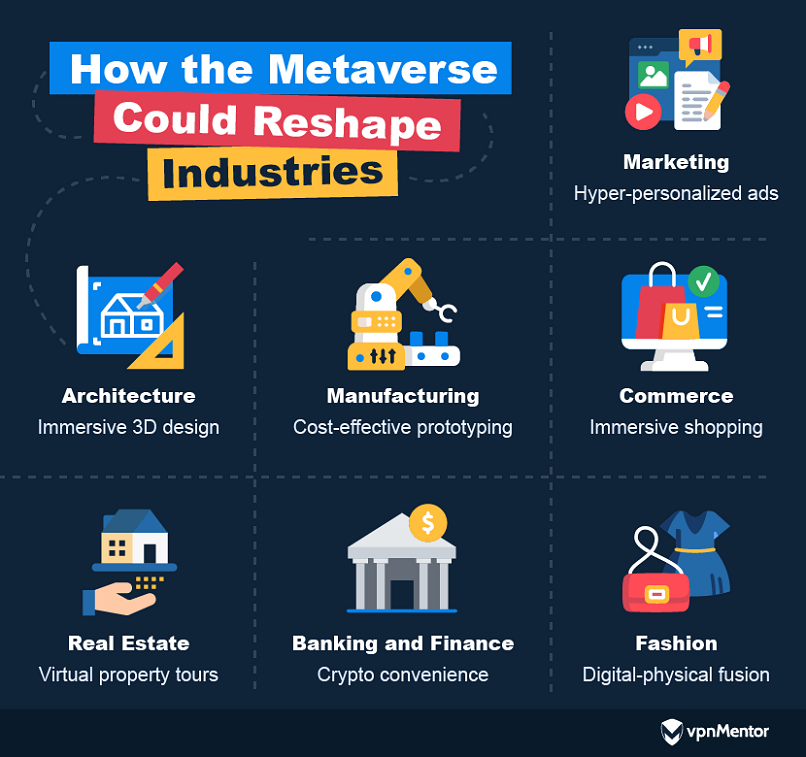
Industries are facing unique challenges as they begin to take advantage of the metaverse’s potential.
While issues around data security, intellectual property rights, and the need to bridge the digital divide are all present, the potential rewards are immense. PwC projects that, in product development alone, VR could contribute up to $360 billion to the global economy by 2030.
Here’s how different industries are harnessing the power of the metaverse:
- Marketing: Personalized advertising could leverage user behavior within the metaverse for interactive brand campaigns. Brands could also use the metaverse to create excitement about new products, like Nike did when it launched digital sneakers and other branded elements in Fortnite.
- Architecture: Firms are already using immersive 3D tours for future projects, enhancing spatial and design understanding. The future may see collaborative design processes in shared virtual spaces and remote site visits.
- Manufacturing: VR helps to reduce the time and costs involved with prototyping new vehicles, something that car manufacturer Ford is already taking advantage of. Future manufacturing solutions could also include virtual replicas of production floors for improved workflow planning.
- Commerce: The metaverse is evolving into a dynamic marketplace. Future shopping experiences could be immersive, incorporating AR and VR with AI-powered customer service. Brands like Nike and Ralph Lauren are already selling digital goods, while platforms like Decentraland enable transactions for virtual land and avatar accessories.
- Real Estate: Virtual property tours are already a reality, allowing potential buyers to view homes from the comfort of the ones they currently live in.
- Banking and Finance: Credit card issuers have begun to offer cryptocurrency debit and credit cards, which allow you to spend your Bitcoin, Ethereum, or other coins like you would fiat currency. Virtual bank branches and AI-staffed customer service portals are other potential future developments.
- Fashion: The fashion industry is embracing the metaverse with an innovative approach, blending physical and digital realms. Brands like Balenciaga and Gucci are pioneering virtual fashion shows and digital accessories, others such as Prada and Dolce & Gabbana are leading the way with “phygital” NFTs, where consumers receive an NFT version of their physical purchase.
The metaverse’s versatile technologies, such as VR, AR, and blockchain, are transforming a wide array of industries. From marketing to architecture and manufacturing, the metaverse offers innovative solutions and future prospects.
Major Players in the Metaverse
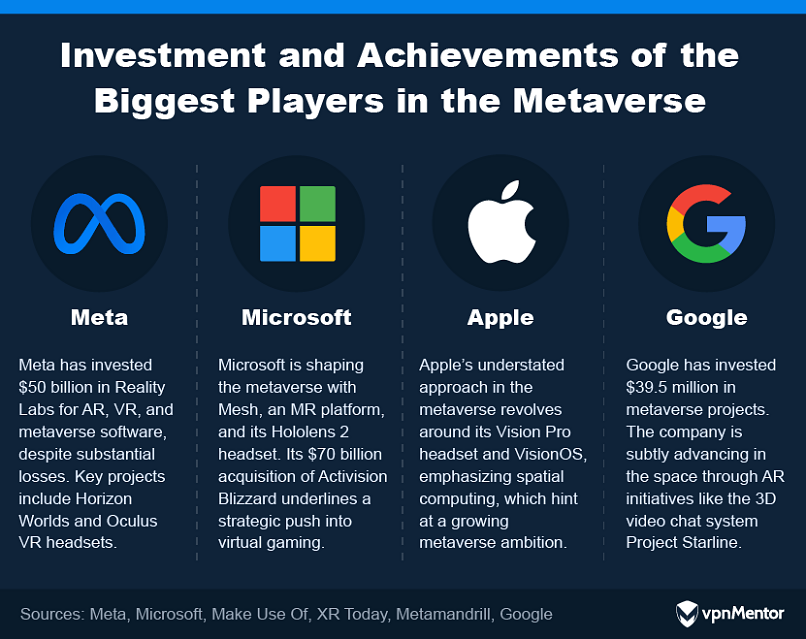
The metaverse is attracting significant attention and investment from leading technology companies. The push towards this virtual frontier is driven by the enormous potential for growth and innovation.
For instance, it’s projected that the metaverse could contribute up to $760 billion to the U.S. GDP by 2035, underscoring its potential as a key driver of economic growth.
This growth is expected to stem from businesses exploiting new revenue opportunities, refining existing models, and enhancing operational efficiencies within the metaverse framework. Early adopters of metaverse technologies are already witnessing tangible benefits, including a 15% reduction in capital expenditure as well as improved sustainability and safety.
Meta
Meta, under CEO Mark Zuckerberg, views the metaverse as the “next chapter of the internet”, a vision extending beyond any single company.
Since its inception in 2019, Meta’s Reality Labs, focusing on VR, AR, and metaverse-related software, has continually faced financial challenges.
In 2021, after rebranding from Facebook, Meta invested approximately $50 billion over four years into the division, aiming to revitalize its efforts. Unfortunately, the company has yet to see any return on this massive investment, although it expects to.
In the first nine months of 2023, Reality Labs recorded an operating loss of $11.5 billion and Meta anticipates “meaningful” increases in operating losses for Reality Labs in 2024.
Meta’s key initiatives in the metaverse space include Horizon Worlds, with over 10,000 VR experiences, and Horizon Workrooms, designed to recreate workplace environments. Additionally, Meta has developed Oculus, a renowned line of VR headsets, and opened the first VR headset store.
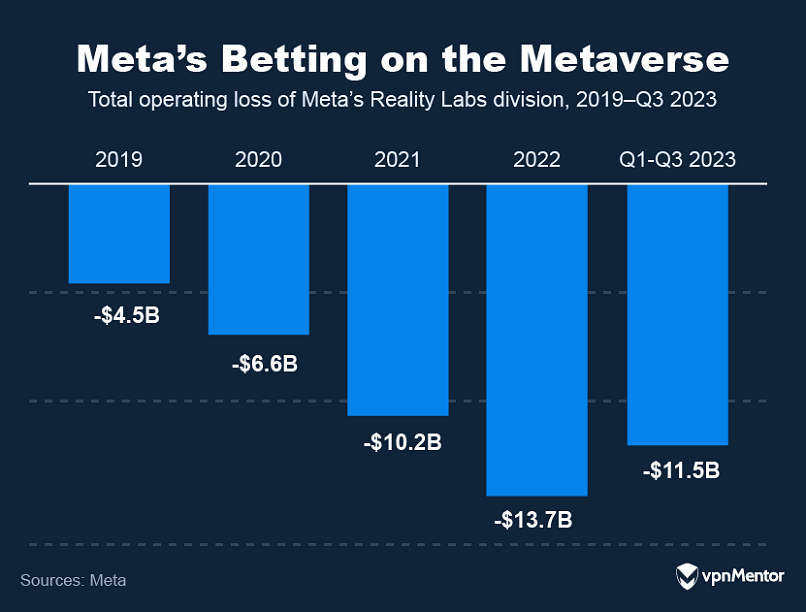
Microsoft
Microsoft is actively building on the metaverse through Mesh, a cloud-based mixed-reality platform designed for collaborative environments.
Mesh leverages the extensive capabilities of Microsoft’s cloud computing platform, Azure, and is aimed at transforming interactive and professional workspaces. It integrates with Hololens 2, the company’s MR head-mounted display.
In 2022, Microsoft acquired video game developer Activision Blizzard for $70 billion, expanding its influence in virtual environments and enabling the company to create Microsoft-backed games and software within the metaverse.
Satya Nadella, CEO of Microsoft, emphasizes, “The metaverse is here, and it’s not only transforming how we see the world but how we participate in it—from the factory floor to the meeting room.”
This vision includes a focus on the industrial metaverse, where Microsoft is integrating a mix of technologies, including IoT, to enhance digital-physical interactions in industries and workspaces.
Apple
While Apple’s vision for the metaverse might not be as explicit as Meta’s or other providers, it is subtly but surely growing. The launch of Apple Vision Pro, Apple’s MR headset, in June 2023 marked a significant stride in this direction.
Controlled by eye, hand, and voice inputs, the headset overlays digital content onto the physical world. It runs on Apple’s metaverse-style operating system, VisionOS, which is built around the concept of spatial computing.
Despite not actively promoting a metaverse vision, Apple’s actions speak volumes. Even amid tech industry layoffs, Apple’s job board lists several roles focused on developing immersive experiences. These steps indicate a commitment to this evolving field, with projections suggesting the Apple Vision Pro could generate $63 billion in revenue by 2032.
Google is primarily strengthening its position in the metaverse through AR technologies. While specifics of Google’s metaverse strategy remain under wraps, the company’s $39.5 million investment in private equity funding for related projects indicates a big commitment.
Several projects hint at Google’s potential direction in the metaverse. These include Google Glass, an early venture into AR glasses, and Project Starline, a 3D video chat system powered by AI that’s currently in its prototype phase.
Google Labs, the company’s AI arm, is also enhancing technologies such as Google Lens and Maps Live View, integrating AI for more immersive experiences.
How to Access the Metaverse
From VR worlds to blockchain-based environments, each metaverse provides a unique experience. This section is designed to help you navigate these diverse virtual spaces, covering the essentials from selecting the right platform to setting up your virtual presence.
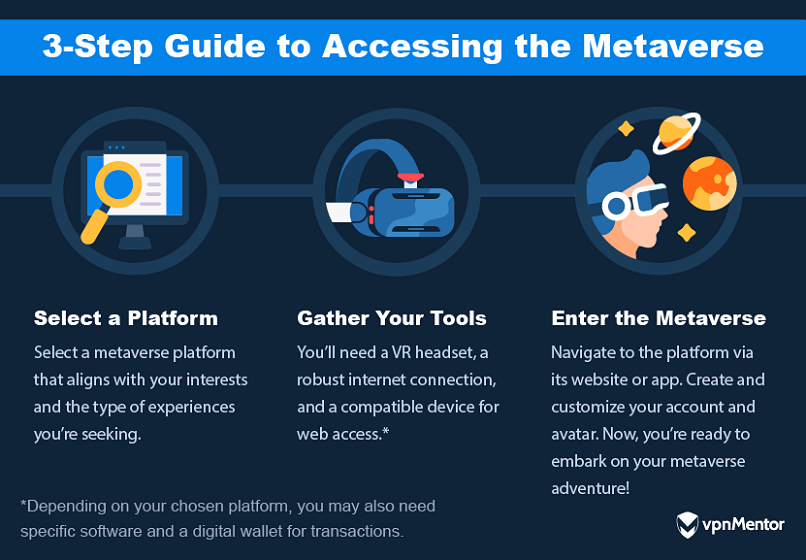
1. Select a Platform
Choosing the right platform is your first step in embarking on your metaverse journey. Each metaverse platform offers a distinct experience, tailored to different interests and interactions.
Here’s an overview of the best use cases for some of the most popular metaverses.
Meta’s Horizon Worlds
Horizon Worlds is focused on social interaction and creativity. Users can build and customize spaces, create virtual homes, and design interactive experiences. It’s ideal for those interested in crafting and exploring user-generated environments.
Roblox
Primarily catering to a younger demographic, Roblox is an excellent platform for creating and playing games. It’s also an educational tool, teaching coding and digital civility. This platform is ideal for young creators and gamers seeking a safe and imaginative play space.
Decentraland
As a decentralized virtual world, Decentraland is perfect for users interested in digital real estate and community governance. It offers a unique experience of owning and developing virtual land, making it appealing to those intrigued by virtual economies and blockchain technology.
The Sandbox
The Sandbox is a blockchain-based, play-to-earn platform. Users can design games and assets using the voxel editor, a software tool that can create 3D content, and have ownership over their creations. It’s a good option for gamers and creators who value asset monetization.
CryptoVoxels
Focused on artistic expression, CryptoVoxels is a virtual city where users can build, own, and showcase digital art and parcels of land. It’s particularly popular among digital artists, offering spaces dedicated to art creation and virtual exhibitions.
2. Gather Your Tools
When venturing into the metaverse, having the right tools is essential for an immersive and functional experience. Here’s a look at what you’ll need:
- VR Headsets: Essential for immersive experiences in VR-focused metaverses, VR headsets (e.g. Meta Quest, Oculus Rift) enable head tracking and interactive environments.
- Computers and Mobile Devices: Modern PCs, Macs, or iOS/Android devices are needed for accessing most metaverses.
- Network/Bandwidth Requirements: A stable and fast internet connection is vital for real-time interactions and exploration, ensuring smooth, lag-free experiences in the metaverse.
- Software and Applications: Specific software, such as the Meta Quest app for VR interfaces or Roblox Studio for game creation, might be necessary depending on the metaverse.
- Digital Wallet and Cryptocurrency: For blockchain-based metaverses like Decentraland and The Sandbox, a digital wallet compatible with the platform’s blockchain (e.g. Ethereum for Decentraland) and respective cryptocurrency (e.g. MANA for Decentraland) is essential for transactions.
3. Enter the Metaverse
How you enter the metaverse can vary depending on the platform you choose. Here’s a breakdown of the general steps you’ll take, with specific examples from Horizon Worlds, Roblox, Decentraland, The Sandbox, and CryptoVoxels.
Access the Platform
For web-based metaverses (Decentraland, The Sandbox, CryptoVoxels), start by navigating to the platform’s website. No need for a gaming console; a PC or Mac with a compatible browser and strong internet connection will suffice.
App-based platforms (Horizon Worlds, Roblox) require you to download an app. For Horizon Worlds, you’ll download the VR app onto your VR headset or mobile device. For Roblox, the app is available on various devices including PCs, mobile phones, and some gaming consoles.
Set Up an Account
Each platform will prompt you to create a unique username. This is your identity in the metaverse, so choose something memorable and personal. As with any online account, choose a strong password and follow any additional security measures suggested by the platform.
Build Your Avatar
Most metaverses offer extensive avatar customization. You can choose from various body types, hairstyles, clothing, and accessories to create an avatar that represents you or your desired persona in the virtual world.
Platforms like Roblox and Horizon Worlds have built-in avatar editors where you can change your appearance. In blockchain-based metaverses like Decentraland and The Sandbox, avatars can also showcase NFTs as clothing or accessories.
Explore and Interact
Once your account is set up and your avatar is ready, you can start exploring. Depending on the platform, you can join games, socialize in virtual spaces, or even create your own environments and games. In metaverses with a digital economy, like Decentraland and The Sandbox, you can also engage in trading digital assets using cryptocurrencies.
Each platform has its own set of controls and user interfaces. VR platforms like Horizon Worlds rely on VR headset controls, while others like Roblox use keyboard and mouse or touchscreen controls. So it’s important to ensure you have the right equipment to get the most out of your experience.
Conclusion
The metaverse isn’t just a technological advancement; it’s a step into a new phase of digital evolution, blending virtual experiences with real-world applications.
As we approach this intersection of technology and daily life, the metaverse presents an opportunity to rethink our digital interactions. It’s a space for potential growth and creativity, but the potential downsides call for us to carefully and considerately navigate its implementation and the effects that may have.
Venturing into this new era, we must balance innovation with responsibility, ensuring that the metaverse develops as a space that enhances human experience in a positive and equitable manner.
Frequently Asked Questions
What Is the Metaverse?
The metaverse is an expansive virtual-reality landscape. It’s powered by VR and AR technology, offering experiences that aim to mimic the real world in an intuitive and lifelike manner.
How Do You Get into the Metaverse?
To get into the metaverse, you’ll first need a reliable internet connection and a suitable device like a computer, smartphone, or game console. Next, choose a platform that suits your interests, create a profile and avatar, and enter the metaverse.
Who Owns the Metaverse?
No single entity owns the metaverse. It’s a collective of various platforms and experiences that’s being shaped by several major technology companies.
Is the Metaverse Free?
The metaverse offers both free and paid experiences. While some aspects of the metaverse can be accessed without charge, other features, especially those involving transactions or exclusive experiences, may require payment.
Can I Enter the Metaverse without a VR Headset?
Yes, you can enter the metaverse without a VR headset. Users only require a computer or a mobile device, along with a stable and fast internet connection to access the majority of the most popular and developed platforms.
Who Are the Biggest Players in the Metaverse?
The metaverse is attracting attention and investment from leading technology companies. Major players include Meta (formerly Facebook), which is heavily investing in VR experiences and platforms, and Microsoft with its Mesh platform for mixed-reality environments.
Is the Metaverse Available to Everyone?
The metaverse is technically available to everyone, but it isn’t universally accessible in its current form. One of the bigger accessibility challenges is that technologies like VR and AR require specific equipment that may not be available to everyone.
How Many Metaverses Are There?
There are multiple metaverses under development. Some are extensions of video games, offering vast digital worlds for player interaction, while others are intended to provide a comprehensive online existence that blends work, socializing, and play.
What Are the Disadvantages of the Metaverse?
Security and privacy concerns, like the vulnerability of NFTs to theft and the potential misuse of personal user information, are two major disadvantages in the metaverse. The environmental impact of the metaverse is another, as the metaverse uses a considerable amount of energy to operate.
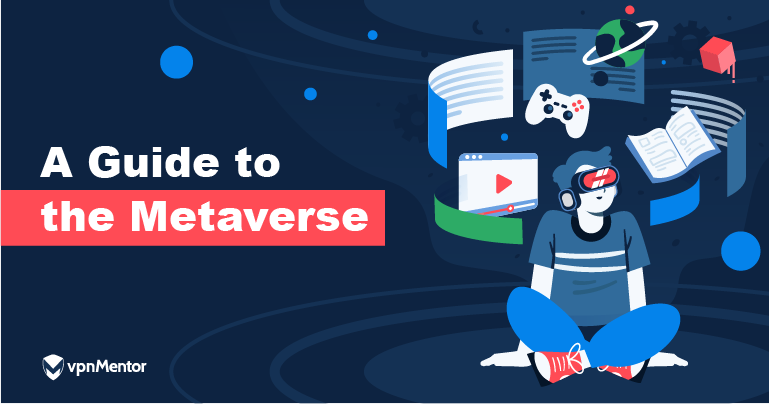



Please, comment on how to improve this article. Your feedback matters!